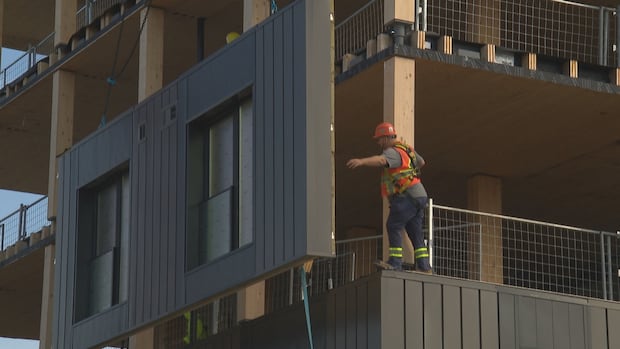TorontoOntario’s sluggish home construction market is beginning to trigger job losses in the trades and hurt the province’s economy, experts say, even as the province moves to refine its housing policy and bolster its incentive programs to spur development.Residential builders CEO says market slowdown means less work for thousands in the trades Shawn Jeffords · CBC News · Posted: Sep 03, 2025 4:00 AM EDT | Last Updated: 2 hours agoA worker helps guide part of a mass timber building wall into place as a 60-unit apartment is built near Mimico GO Station. Housing advocates point to the ‘missing middle’ project as one the province should emulate on a larger scale. (Vedran Lesic/CBC News)Ontario’s sluggish home construction market is beginning to trigger job losses in the trades and hurt the province’s economy, a group representing builders warns, even as the province moves to refine its housing policy and bolster its incentive programs to spur development.The Residential Construction Council of Ontario, which represents residential builders, says it is beginning to see the impact of slow housing starts, as layoffs begin to take hold. Richard Lyall, who is CEO of RESCON, said the pipeline of projects has begun to dry up and builders are struggling to make the finances work and get shovels in the ground.”We’re in the process of laying off thousands of people right now,” he said. “So, a year from now, give or take, those people that are working on all those high-rise projects that are getting finished are going to be unemployed, which is terrible.” Last month, a report from the Financial Accountability Office of Ontario said unemployment across the province has jumped to 7.8 per cent — the highest rate since late 2012, excluding the pandemic. The province lost 38,000 jobs between April and June.The bulk of that — over 29,000 jobs — were lost in manufacturing due to U.S. President Donald Trump’s tariffs. Tariffs on steel and aluminum have also hurt home construction, contributing to an increase in the cost of materials.WATCH | Ontario’s housing market is at a ‘standstill.’ Officials want to change that: Ontario’s housing market is at a ‘standstill.’ Officials want to change thatPremier Ford’s government says it’s in talks with municipalities to change a billion-dollar fund at a time when new home construction has slowed. CBC’s Shawn Jeffords has reaction from critics who say the proposed plan isn’t enough to spur development. Layoffs will impact workers in the trade and planning teams: RESCON CEOLyall said it’s not just construction workers, but also the project management and planning teams behind them.”We’re talking about tens of thousands people that are going to be unemployed, and it’s already started,” he said.Ontario’s housing starts have been slowing for months, with Municipal Affairs Minister Rob Flack acknowledging last week that building has come to a “standstill.” The province missed its goal of building 125,000 new homes, hitting about 75 per cent of that mark — over 94,000 — in 2024. That puts Ontario off track when it comes to reaching the Ford government’s pledge of building 1.5 million homes by 2031.In the face of those softening numbers, the province has introduced new policies to change zoning rules around transit, defer payment of development charges and said it is open to changing a billion-dollar-incentive fund that rewards municipalities for building housing.Premier Doug Ford said Tuesday that his government is trying to “create the environment” for builders to get shovels in the ground. But he said there are things out of the province’s control, like interest rates which can prevent builders from moving ahead with projects.”The Bank of Canada, they have to lower the interest rates,” he said. “And you know, they can’t just keep saying no, no, no, no.”Premier Doug Ford says his government is urging the Bank of Canada to cut interest rates to help get builders back to work on housing. (Alex Lupul/CBC)Ontario urged to cut taxes and fees to spur developmentLyall said the province could cut taxes, fees and charges that are under its control, including HST for first time homebuyers.”The feds did that, made it effective May 27, but it’s been stalled at the province of Ontario,” he said. “That has hurt the summer market, and it’s going to continue hurting the fall market.”Housing advocate Mark Richardson said the province could do more to address the slowing market and job losses by investing in “missing middle” projects to get housing build and keep people working.He points to a mass timber project being built in Etobicoke near Mimico GO Station as an example of a 60 rental apartments near transit that Ontario should emulate. Many elements of the building are prefabricated off-site and delivered to be assembled on location. And as builders struggle to secure financing for large projects, smaller developments like this one could be the way forward, he said.It could also open the door for companies that build the prefabricated materials to set up shop in the province, creating manufacturing jobs, he said.”These kinds of smaller infill projects, we can make hundreds of them,” said Richardson, HousingNowTO’s technical lead.He also urged the province to also get more involved in matching capital grants for builders like the City of Toronto and federal government. “We actually need to see the province of Ontario putting their hands in their pockets,” he said.Karen Chapple, director of the School of Cities at the University of Toronto, said the province is in an unusual position where demand for rentals and housing has slumped, which has seen affordability improve. But that’s going on while housing starts have stalled, which means that if more stock isn’t built it will create a tight housing market in a few years.”Prices are going to go back up, and we’re going to lose all this wonderful affordability that we have, so that’s really the dilemma we face,” she said.Chapple said addressing the changing housing environment will take alignment from all three levels of government, and active intervention from each. They can also seize the moment to help address rising unemployment from the slowed housing market, she said.”Let’s have a big initiative to help subsidize labour, as well as build that (housing) pipeline back up, before we start losing our labour talent,” she said.ABOUT THE AUTHORShawn Jeffords is CBC Toronto’s Municipal Affairs Reporter, but is currently covering the Ontario Legislature. He has previously covered Queen’s Park for The Canadian Press. You can reach him by emailing shawn.jeffords@cbc.ca.
Monday, 22 Dec 2025
Canada – The Illusion
Search
Have an existing account?
Sign In
© 2022 Foxiz News Network. Ruby Design Company. All Rights Reserved.
You May also Like
- More News:
- history
- Standing Bear Network
- John Gonzalez
- ᐊᔭᐦᑊ ayahp — It happened
- Creation
- Beneath the Water
- Olympic gold medal
- Jim Thorpe
- type O blood
- the bringer of life
- Raven
- Wás’agi
- NoiseCat
- 'Sugarcane'
- The rivers still sing
- ᑲᓂᐸᐏᐟ ᒪᐢᑿ
- ᐅᑳᐤ okâw — We remember
- ᐊᓂᓈᐯᐃᐧᐣ aninâpêwin — Truth
- This is what it means to be human.
- Nokoma










